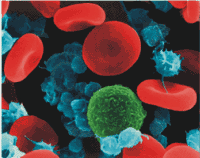|
Life Processes and Cell Activities
The 7 life processes are what all living organisms do. Remember the phrase "MRS GREN"
|
M
|
Movement
|
Animals move to find food and away from predators.
Plants move towards light.
|
|
R
|
Reproduction
|
Both animals and plants reproduce to make their species carry on.
|
|
S
|
Sensitivity
|
Organisms react to their environment. (think 5 senses) (Plants react to light.)
|
|
G
|
Growth
|
Animals grow larger and stronger which helps them hunt better.
|
|
R
|
Respiration
|
Animals and plants must turn their food into energy.
|
|
E
|
Excretion
|
Waste products must be excreted from plants and animals.
|
|
N
|
Nutrition
|
Animals need food for respiration and plants need minerals from the soil.
|
|
| Cell Parts - Organelles |
| Protoplasm |
Consists of cytoplasm and nucleus. |
| Cytoplasm |
Jelly like substance where chemical reactions take place and other parts are embedded. |
| Nucleus |
Controls reproduction. Contains the characteristics of the cell. Acts like the brain. Tells the cell what to do. |
| Cell membrane |
Surrounds the cell and controls what moves in and out of the cell. |
| Mitochondria
|
The powerhouse of the cell. These organelles break down stored food and release energy. Cells use this energy to fuel all activities. |
| Chloroplasts
|
These make plants green. They contain chlorophyll which is needed for photosynthesis (food production). |
| Cell wall |
Gives the cell its shape. The cell's "skeleton". |
| Vacuoles |
Sac-like organelle. Stores excess food, waste and other substances. |
|
| Differences
Between the Animal and Plant Cells |
|
Structurally,
plant and animal cells are similar. They both contain
membrane-bound organelles such as the nucleus,
mitochondria, endoplasmic reticulum, golgi apparatus &
lysosomes. Both contain
similar membranes. However, the few differences that
exist between plant & animals are significant
and reflect a difference in the functions of
each cell.
| Plant
cell |
Animal
cell |
|

Fixed structure.
Has a cellulose cell wall & cell membrane
Chlorophyll in chloroplasts
Large
vacuoles
|

Can
change shape.
No Cellulose cell wall
No Chlorophyll or chloroplasts
Small
or no vacuoles
|
|
| Tissues,
Organs and Organ Systems |
|
 Tissues
- Made up of lots of cells of the same type.
(e.g. muscle tissue is made up of many muscle
cells) Tissues
- Made up of lots of cells of the same type.
(e.g. muscle tissue is made up of many muscle
cells)
Organs
- Different tissues working together to carry
out a certain function. An organ can contain
different types of tissue (e.g. the heart).
Organ
Systems - Organ systems are composed of
two or more different organs that work together
to provide a common function.
|